You are here: Urology Textbook > Surgery (procedures) > Cystolitholapaxy
Cystolitholapaxy: Transurethral or Percutaneous Technique
Indications for Cystolitholapaxy
Bladder stones are treated surgically by endoscopic cystolitholapaxy or open surgery. The decision between endoscopic or open surgery depends on the size of the stones, number of stones, and size of the prostate if simultaneous treatment of benign prostatic hyperplasia is sought.
Contraindications for Cystolitholapaxy
- Untreated urinary tract infection
- Coagulation disorders
- Further contraindications depend on the surgical risk due to the patient's comorbidity.
Surgical Technique of Cystolitholapaxy
For patient preparation, anesthesia, and perioperative antibiotic prophylaxis, see the section on Transurethral Resection of the Prostate.
Mechanical lithotripsy with a Stone Punch:
A stone punch is resembles a resectoscope, it is equiped with a crushing blade and a 5-degree optical lens. The stone is desintegrated (like with a nutcracker) into large fragments, which can be retrieved via the sheath [fig. cystolitholapaxy with a stone punsh]. The fragments in patients with a significant stone burden may be removed with the Ellik evacuator or bladder glass syringe.
 |
Electrohydraulic Lithotripsy (EHL):
The electric discharge triggered by a probe results in a pressure wave in the vicinity of the bladder stone, which leads to disintegration [fig. electrohydraulic lithotripsy]. The fragments are removed with the Ellik evacuator or bladder glass syringe.
 |
Pneumatic Lithotripsy:
Pneumatic lithotripsy transmits mechanical energy via a rigid probe on the stone. 8 CH probes are available for bladder stones. The fragments are removed with the Ellik evacuator or bladder glass syringe.
Laser Cystolithotomy
Modern laser systems generate sufficient power to disintegrate even larger bladder stones in a reasonable time. The small sand-like disintegrates can be easily flushed out. Laser lithotripsy is very simple and less dangerous than the above-mentioned procedures. It is also possible via a suprapubic approach using PNL equipment. Percutaneous suprapubic laser lithotripsy spares the urethra and is the method of first choice in children.
Postoperative Care
Quick removal of the bladder catheter is possible after an uneventful procedure (no bleeding or fever, no additional procedure) after one day.
Complications of Cystolitholapaxy
Perforation of the bladder is a typical complication. Beware of using electrohydraulic lithotripsy near the bladder wall, and exercise caution not to grasp the bladder wall with the stone punch. Further complications are bleeding, infection, and urethral injury resulting in urethral strictures. Conversion to open surgery is an option if the stone burden is too significant.
| Urologic Surgery | Index | TURB |
Index: 1–9 A B C D E F G H I J K L M N O P Q R S T U V W X Y Z
References
 Deutsche Version: Harnblasensteinlithotripsie
Deutsche Version: Harnblasensteinlithotripsie
Urology-Textbook.com – Choose the Ad-Free, Professional Resource
This website is designed for physicians and medical professionals. It presents diseases of the genital organs through detailed text and images. Some content may not be suitable for children or sensitive readers. Many illustrations are available exclusively to Steady members. Are you a physician and interested in supporting this project? Join Steady to unlock full access to all images and enjoy an ad-free experience. Try it free for 7 days—no obligation.
New release: The first edition of the Urology Textbook as an e-book—ideal for offline reading and quick reference. With over 1300 pages and hundreds of illustrations, it’s the perfect companion for residents and medical students. After your 7-day trial has ended, you will receive a download link for your exclusive e-book.